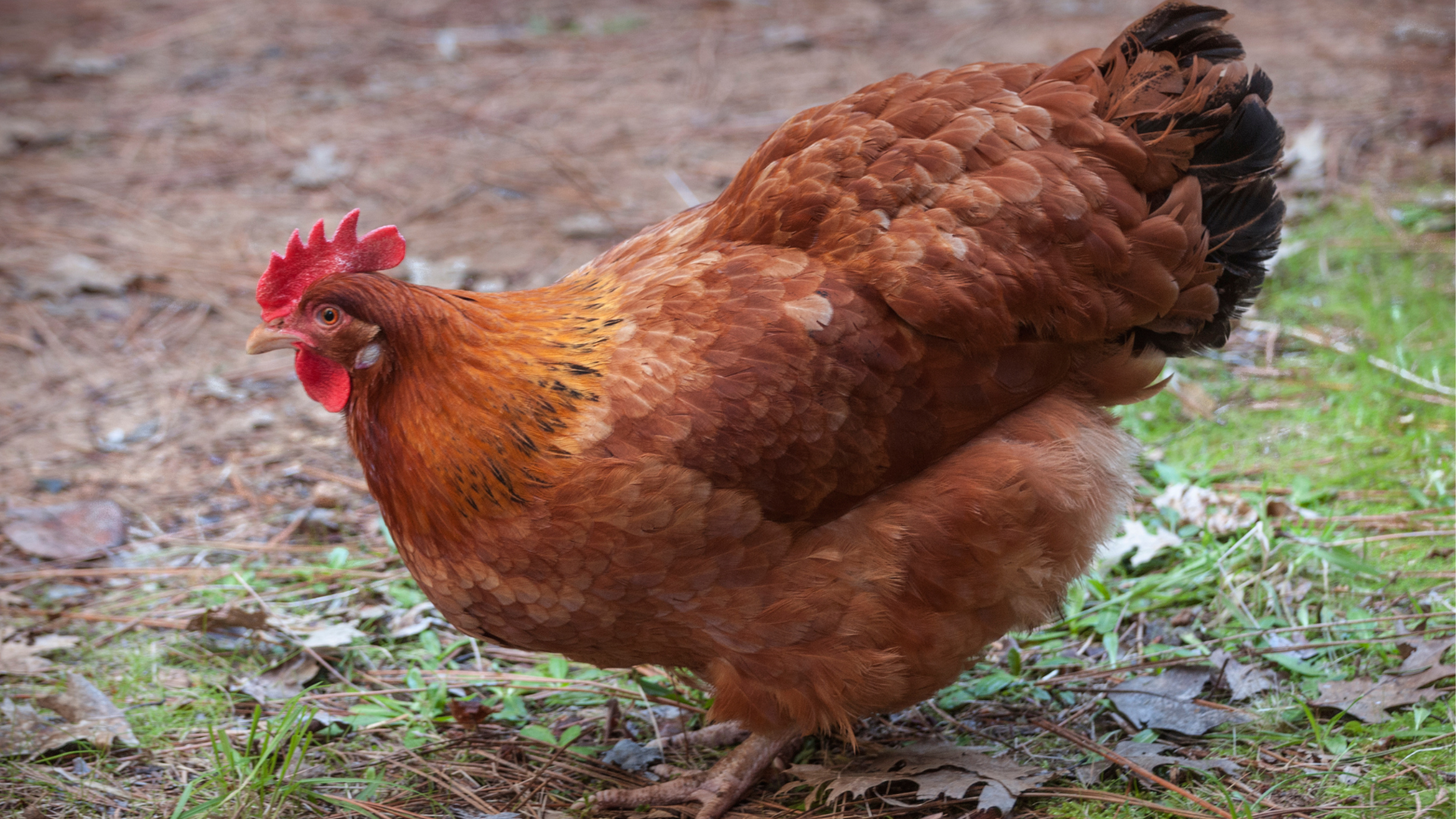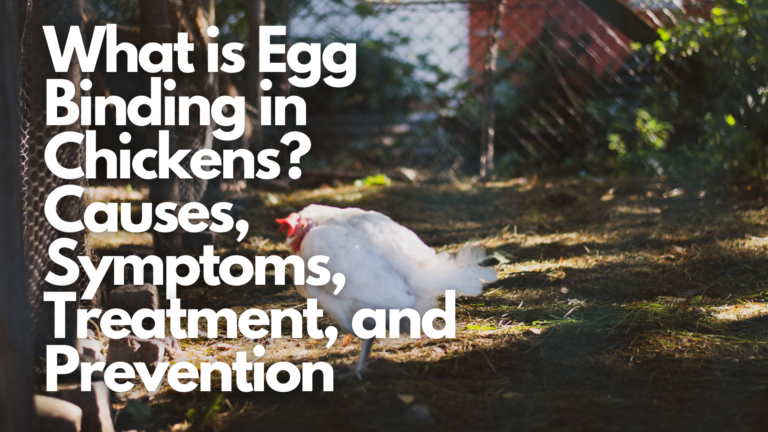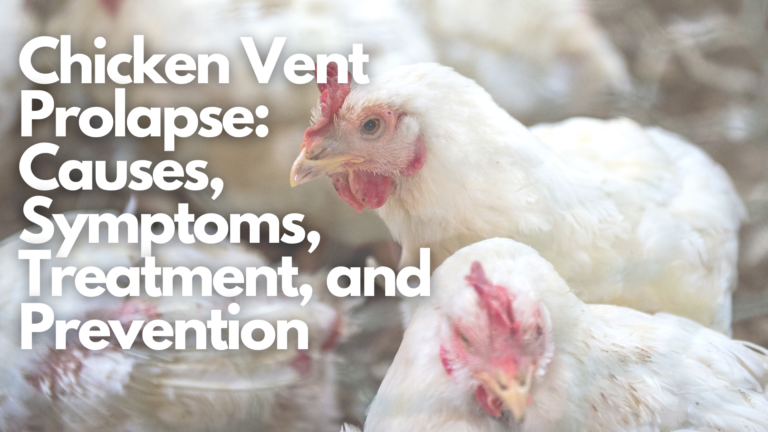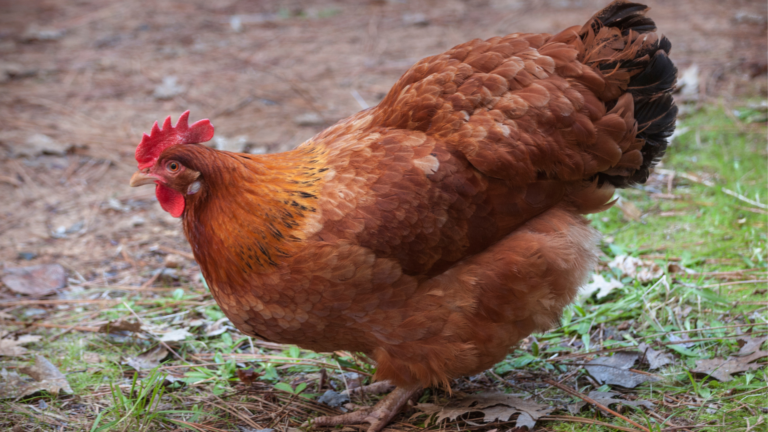Few can match the timeless allure and versatility of the Rhode Island Red. With its rich mahogany feathers, robust size, and remarkable dual-purpose capabilities, the Rhode Island Red has been a favorite among chicken enthusiasts for over a century. Whether you’re seeking an abundant supply of fresh, brown eggs or a flavorful addition to your dinner table, these birds offer a winning combination of productivity and beauty.
Join us as we embark on a journey to discover the captivating world of Rhode Island Reds. Whether you’re a seasoned poultry enthusiast or a curious beginner, this article will provide you with the knowledge and insights needed to appreciate and care for these exceptional birds. Get ready to embrace the charm and utility of the Rhode Island Red, a breed that continues to captivate and impress with its enduring legacy of excellence.
The Origin of Rhode Island Reds
Rhode Island Reds have a rich and fascinating history that dates back to the mid-19th century in the small state of Rhode Island, United States. The breed’s development involved a careful and purposeful selection process, combining the traits of various chicken strains to create a superior dual-purpose breed.
During the early 1800s, farmers in Rhode Island sought to create a chicken breed that could thrive in the rugged New England climate while providing both meat and eggs for their households. They began crossbreeding several chicken varieties, including the Malay, Shanghai, and Java breeds, which were known for their hardiness and egg-laying abilities.
The influence of the Malay breed is particularly significant in the development of Rhode Island Reds. Malays were large, robust birds with excellent meat qualities. Their strength and vigor were desired traits, as farmers wanted a breed that could endure the harsh winters and still provide a reliable source of food.
The introduction of the Shanghai and Java breeds brought forth enhanced egg-laying capabilities. These strains contributed to the breed’s prolific egg production and refined the overall appearance of Rhode Island Reds. Through successive generations of selective breeding, the breeders were able to establish consistent traits and characteristics in their flocks.
The hard work and dedication of these Rhode Island farmers paid off, as they successfully developed a breed that excelled in both meat and egg production. The breed quickly gained popularity not only in Rhode Island but also throughout the United States and eventually around the world.
In 1904, Rhode Island Reds were officially recognized by the American Poultry Association (APA) as a distinct breed. This recognition further solidified their status and helped promote their widespread adoption among poultry enthusiasts and commercial farmers alike.
Today, Rhode Island Reds are recognized as one of the most iconic and influential chicken breeds in the world. Their remarkable traits, including their exceptional egg-laying abilities, hardiness, and friendly temperament, have made them a favorite among chicken keepers of all levels of experience.
As you embark on your journey of raising Rhode Island Reds, it’s worth appreciating the breed’s origins and the dedication of the farmers who selectively bred these chickens to create such a versatile and enduring breed.
Why are Rhode Island Reds So Popular?
Rhode Island Reds have garnered immense significance and popularity in the world of poultry due to their exceptional egg-laying abilities and versatility as a dual-purpose breed. Originally bred to meet the demands of early American farmers for a breed that could provide both meat and eggs, Rhode Island Reds quickly established themselves as a remarkable breed that excelled in various aspects.
The dual-purpose nature of Rhode Island Reds initially attracted farmers seeking a reliable source of both meat and eggs. The breed’s larger size and well-developed muscles made them suitable for meat production. Their meat was known for its flavorful taste and succulent texture, satisfying the culinary preferences of many households.
However, it was their outstanding egg-laying capabilities that truly set Rhode Island Reds apart and propelled them to the forefront of the poultry world. As early as the 19th century, these chickens began demonstrating an extraordinary aptitude for producing a significant number of eggs. Farmers soon realized that Rhode Island Reds had an unmatched ability to consistently lay large-sized eggs – and in substantial quantities.
This exceptional egg production quickly became the distinguishing characteristic of the breed. Rhode Island Reds were celebrated for their reliability as consistent layers, even during adverse weather conditions. Their ability to provide a consistent supply of high-quality eggs was highly valued by farmers, households, and the commercial market alike.
Word of the Rhode Island Reds’ remarkable egg-laying capabilities spread rapidly, leading to their popularity not just in their home state but throughout the United States and beyond. Poultry enthusiasts and farmers started incorporating Rhode Island Reds into their flocks, recognizing the breed as a reliable and productive source of eggs.
To this day, Rhode Island Reds remain one of the most popular and sought-after chicken breeds. Their exceptional egg-laying abilities have made them a staple in many households and farms, ensuring a steady supply of fresh and nutritious eggs. Their versatility as a dual-purpose breed, excelling in both meat production and egg-laying, continues to make them a valuable asset to poultry enthusiasts and those seeking self-sufficiency.
Key Characteristics and Traits of Rhode Island Red Chickens
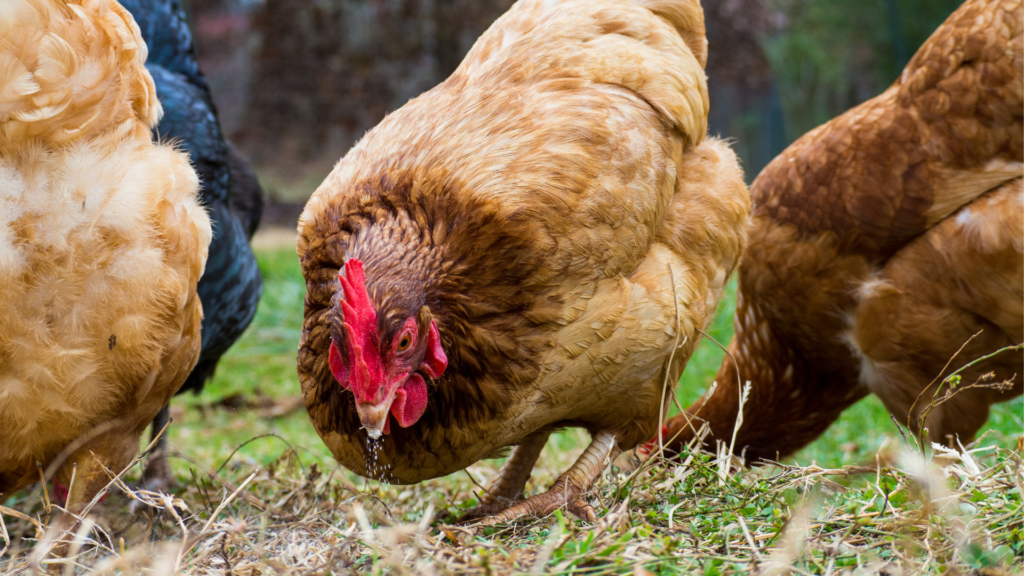
Body Shape and Size
Rhode Island Reds exhibit a medium to large-sized body with a well-rounded shape. They have a broad and deep chest, which indicates their robust constitution. Their body is compact and muscular, giving them a sturdy and substantial appearance. The females tend to be slightly smaller in size compared to the males. The overall body shape of Rhode Island Reds is well-balanced, with proportional body parts.
Feather Color and Pattern
The feather coloration of Rhode Island Reds is striking and distinctive. Their feathers display a deep mahogany or dark red color, often described as a rich, rusty red hue. This coloration extends uniformly throughout their body, including the head, neck, back, wings, and tail. The feathers have a glossy sheen that adds to their visual appeal. This attractive color pattern is consistent in both males and females of the breed.
Temperament and Behavior
Rhode Island Reds are renowned for their docile and friendly temperament. They tend to have a calm and easygoing disposition, which makes them well-suited for backyard settings and small farms. They are not known to be aggressive or high-strung, which can make them easier to handle and manage. Their generally calm demeanor contributes to their popularity among chicken enthusiasts.
Interaction with Humans and Other Chickens
Rhode Island Reds are sociable birds that typically enjoy human interaction. They can develop a bond with their owners and are known to be tolerant and friendly towards people. They are often curious and will readily approach their caretakers. This makes them suitable for families with children who want to engage with their chickens. In terms of their interaction with other chickens, Rhode Island Reds generally exhibit good social behavior. They tend to be peaceful within a flock, although some minor dominance behaviors may occur as they establish a hierarchy.
Unique Features of the Rhode Island Red
Dual-purpose capabilities
Rhode Island Reds are highly regarded as a dual-purpose breed due to their exceptional qualities for both egg production and meat quality. As prolific layers, they consistently produce a good number of large brown eggs throughout the year. Their egg-laying ability is reliable and valued by those seeking a consistent supply of fresh eggs. Moreover, Rhode Island Reds are known for their flavorful and well-marbled meat, making them an excellent choice for those interested in meat production. Their ability to excel in both egg and meat production sets them apart as a versatile breed.
Adaptability to various climates
Rhode Island Reds possess remarkable adaptability to different climates, making them suitable for various geographical locations. They have a hardy nature that allows them to withstand a wide range of weather conditions. In colder climates, their dense plumage, consisting of an undercoat and guard feathers, provides excellent insulation. This insulation helps them retain body heat and stay warm during chilly periods. On the other hand, their feathers are designed to allow airflow, facilitating heat dissipation in warmer climates. This adaptability to different climates allows Rhode Island Reds to thrive and remain comfortable in diverse environments, making them popular choices for chicken keepers worldwide.
Raising Rhode Island Reds
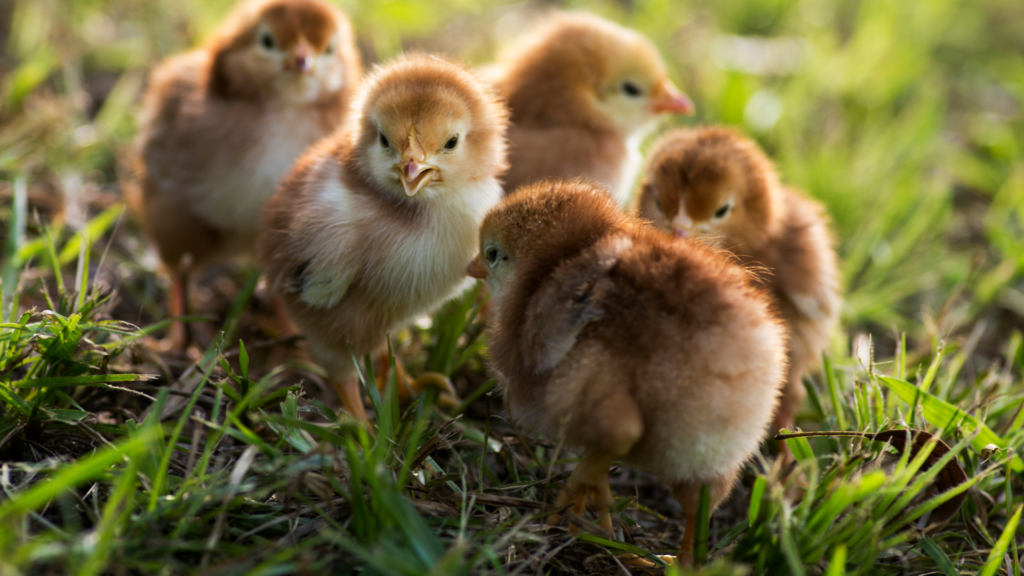
Housing and space requirements
Rhode Island Reds, like most chickens, require suitable housing and adequate space to thrive. Consider the following guidelines for housing your Rhode Island Reds:
Coop
Provide a secure and predator-proof coop that offers protection from extreme weather conditions. The coop should have proper ventilation to maintain air circulation while preventing drafts. It should be spacious enough to accommodate the number of chickens you have, allowing each bird to have at least 4 square feet of indoor space.
Roosting bars
Install sturdy roosting bars inside the coop, allowing each chicken to have enough space to comfortably perch at night. The bars should be wide enough for them to grip without straining their feet.
Nesting boxes
Allocate nesting boxes for egg-laying. Provide one nesting box for every 3-4 hens. Each nesting box should have soft bedding material, such as straw or wood shavings, to provide comfort and encourage egg laying.
Outdoor run or free-ranging
Rhode Island Reds benefit from having access to a secure outdoor run or free-ranging area during the day. This allows them to exhibit natural behaviors, forage for insects and plants, and enjoy the sunshine. The run should be adequately fenced to prevent predators from entering and should have ample space for the chickens to move around and stretch their wings.
Feeding and nutrition
Proper nutrition is crucial for the health and productivity of Rhode Island Reds. Follow these feeding guidelines:
Commercial feed
Provide a high-quality layer feed formulated specifically for chickens. Layer feed contains the necessary balance of protein, vitamins, minerals, and calcium to support egg production.
Supplementary treats
Offer a variety of fresh fruits, vegetables, and kitchen scraps as occasional treats. These treats can provide additional nutrients and also help keep the chickens entertained. However, treats should only comprise a small portion of their overall diet, with the majority coming from a balanced layer feed.
Grit and calcium supplementation
Provide a separate container of grit to help the chickens digest their food. Grit aids in the breakdown of food in the gizzard. Additionally, offer oyster shell or another calcium supplement to ensure proper eggshell formation.
Health care and disease prevention
Common health issues and treatments
While Rhode Island Reds are generally hardy, it’s important to monitor their health and be aware of common health issues such as:
- Parasites: Regularly inspect the chickens for external parasites like mites and lice. Treat infestations with appropriate parasiticides as recommended by a veterinarian.
- Respiratory infections: Watch for signs of respiratory issues such as coughing, sneezing, or nasal discharge. If any symptoms arise, consult a veterinarian for proper diagnosis and treatment.
- Vent prolapse: Occasionally, hens may experience vent prolapse, where the cloaca protrudes from the body. This requires immediate veterinary attention to prevent infection or further complications.
- Vaccination schedules: Consult with a poultry veterinarian to determine the appropriate vaccination schedule for your Rhode Island Reds. Vaccinations can help protect against common diseases such as Marek’s disease, Newcastle disease, and infectious bronchitis. Vaccination protocols may vary based on regional disease prevalence and specific flock management practices.
Exercise and environmental enrichment
Rhode Island Reds benefit from exercise and environmental enrichment. Consider the following:
- Free-ranging: If possible, allow your chickens to free-range in a secure area during the day, enabling them to engage in natural behaviors like scratching, pecking, and exploring.
- Dust bathing: Provide a designated area or box filled with loose dirt or sand for the chickens to engage in dust bathing. Dust bathing helps keep their feathers clean and controls parasites.
- Perches and toys: Install perches of varying heights inside the coop or run, allowing the chickens to exercise their leg muscles and roost. Additionally, consider providing toys or hanging treats for them to peck at, such as a hanging cabbage or a chicken-friendly piñata, to stimulate their natural foraging instincts and keep them mentally engaged.
General care and maintenance tips
To ensure the well-being of your Rhode Island Reds, follow these general care and maintenance tips:
- Regular cleaning: Keep the coop and nesting boxes clean by removing soiled bedding regularly. This helps maintain good hygiene and prevents the buildup of bacteria or parasites
- Fresh water: Provide clean and fresh water at all times. Check waterers daily to ensure they are functioning properly and refill as needed.
- Egg collection: Collect eggs daily to prevent them from being pecked or becoming soiled. Promptly remove any broken or cracked eggs to avoid attracting pests or causing egg-eating behaviors.
- Regular health checks: Monitor your chickens regularly for any signs of illness or injury. Check their feathers, eyes, beaks, and legs for abnormalities. Address any health concerns promptly and consult a veterinarian when necessary.
- Predator protection: Secure the coop and run to protect your Rhode Island Reds from predators such as foxes, raccoons, or hawks. Ensure fences are sturdy, cover openings with predator-proof mesh, and consider using motion-activated lights or alarms for added security.
- Socialization: Spend time with your Rhode Island Reds, interacting and handling them gently. This helps them become more comfortable around humans and promotes positive socialization.
- Record keeping: Maintain a record of important information, such as vaccinations, health checks, and egg production. This can be helpful for tracking their health, productivity, and overall well-being.
Providing appropriate housing, nutrition, healthcare, exercise, and care, you can raise healthy and happy Rhode Island Reds. Regular monitoring and attention to their needs will contribute to their overall well-being and optimize their performance as productive and enjoyable backyard chickens.
Rhode Island Red Egg Laying Capacity
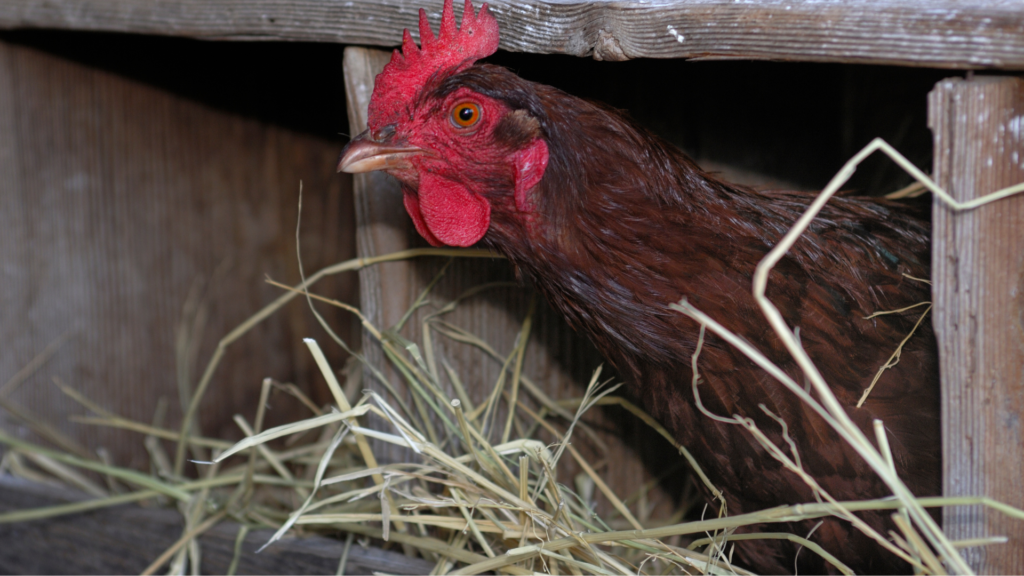
Average number of eggs per week
Rhode Island Reds have a reputation for their consistent egg-laying capacity. On average, a healthy and well-cared-for Rhode Island Red hen can lay around 4 to 6 eggs per week. This translates to approximately 200 to 300 eggs per year, depending on individual factors and environmental conditions.
Factors influencing egg production
Several factors can influence the egg production of Rhode Island Reds, including:
- Age: Hens generally reach peak egg production between 6 to 8 months of age. Egg production may decline as they get older.
- Diet and nutrition: Providing a balanced and nutrient-rich diet is crucial for optimal egg production. High-quality layer feed with adequate protein, vitamins, and minerals supports healthy egg production.
- Lighting: Rhode Island Reds, like most chickens, require adequate lighting to stimulate consistent egg production. Exposure to about 14 to 16 hours of light per day, either natural or artificial, helps maintain steady egg-laying.
- Season and daylight: While Rhode Island Reds are known for their year-round egg-laying, there can still be slight fluctuations in production during seasons with shorter daylight hours. Supplemental lighting can help mitigate this effect.
- Stress levels: A calm and stress-free environment is beneficial for consistent egg production. Minimizing disturbances, providing proper housing, and reducing exposure to predators or extreme weather conditions can help maintain optimal egg-laying.
Egg Characteristics of the Rhode Island Red
Egg size, color, and quality
Rhode Island Red eggs are typically large in size. They are known for producing eggs with a strong shell and a rich brown color. The eggs are visually appealing, and many people appreciate their natural and rustic appearance. In terms of quality, Rhode Island Red eggs have a good yolk-to-white ratio and are known for their delicious flavor.
Shell strength and integrity
Rhode Island Reds generally lay eggs with strong and durable shells. The shells are designed to protect the developing embryo and maintain the egg’s integrity during handling and transportation. Proper nutrition, including adequate calcium levels in the diet, is essential for maintaining strong shell quality. Providing oyster shell or calcium supplements can help ensure adequate calcium intake for shell formation.
Tips for maximizing egg production in Rhode Island Reds
Optimal nutrition and diet
Providing a well-balanced and nutritious diet is crucial for maximizing egg production. Feed your Rhode Island Reds a high-quality layer feed that contains the necessary nutrients, including protein, calcium, vitamins, and minerals. Supplement their diet with fresh vegetables, fruits, and greens to provide additional nutrients. Clean, fresh water should be available at all times.
Providing suitable nesting boxes
Having suitable nesting boxes encourages hens to lay their eggs in designated areas, which makes collecting and preserving the eggs easier. Nesting boxes should be clean, private, and filled with soft bedding material such as straw or wood shavings. The boxes should be well-positioned in a quiet and comfortable area of the coop, away from disturbances or excessive light.
Regularly collecting eggs from the nesting boxes is important to prevent hens from becoming broody or starting to eat their eggs. Inspect the nesting boxes daily and promptly remove any broken or dirty eggs to maintain cleanliness.
By providing a nutritious diet, ensuring appropriate lighting, minimizing stress, and providing suitable nesting boxes, you can maximize the egg production of your Rhode Island Reds and enjoy a consistent supply of high-quality eggs.
Breeding and Incubation
Breeding considerations
- Selecting breeding stock:When breeding Rhode Island Reds, it’s important to select healthy, high-quality breeding stock. Consider the following factors:
- Health and vigor: Choose birds that are free from any genetic or health issues. Look for individuals with vibrant feathers, clear eyes, good body conformation, and an alert demeanor.
- Productivity: Select birds that come from productive egg-laying lines. Look for hens with a consistent and reliable egg-laying record, and roosters that come from a lineage of good egg producers.
- Conformation and breed standards: Choose birds that adhere to the breed’s physical characteristics and standards. This includes features like the correct body shape, size, feather color, and pattern specific to Rhode Island Reds.
Breeding Techniques and Method
There are a few methods you can use for breeding Rhode Island Reds:
- Natural mating: Allow the rooster and hens to freely mate in a flock setting. This is the most natural method of breeding. Ensure a healthy ratio of one rooster for every 8 to 10 hens to prevent excessive mating stress on the hens.
- Selective breeding: If you have specific traits you want to emphasize or improve in your flock, you can practice selective breeding. This involves carefully choosing which individuals to breed based on desired traits and consistently selecting offspring that exhibit those traits in subsequent generations.
Once you have bred your Rhode Island Reds, it is time for the incubation process.
Collecting and Storing eggs
To have a successful incubation process, follow these guidelines for collecting and storing eggs:
Collect eggs daily: Collect eggs regularly to ensure freshness. Avoid leaving eggs in the nest for extended periods as this can reduce hatchability.
Handle eggs gently to avoid cracking or damaging the shell. Rough handling can compromise the integrity of the eggs and reduce their viability.
Store eggs properly
If you’re not ready to incubate the eggs immediately, store them in a cool and humid environment with a temperature of around 50 to 60°F (10 to 15°C) and a humidity level of 75 to 80%. Store the eggs with the pointed end facing down to help preserve their freshness and maintain the integrity of the air cell.
Incubator setup and management
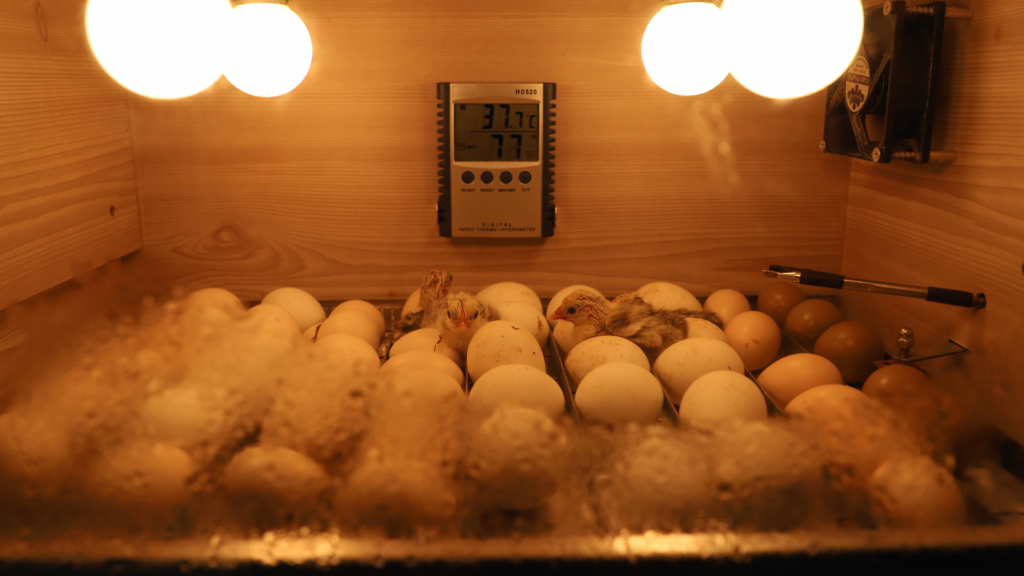
When setting up the incubator for Rhode Island Red eggs, consider the following:
Temperature and humidity: Set the incubator to the recommended temperature of 99.5°F (37.5°C) with a relative humidity of about 50 to 55% for the first 18 days. Increase the humidity to around 65% for the final days of incubation to facilitate hatchability.
Turning the eggs
Eggs should be turned regularly to prevent the embryos from sticking to the shell and to promote proper development. Automatic egg turners are commonly used in incubators, but if you don’t have one, manually turn the eggs at least three times a day.
Candling
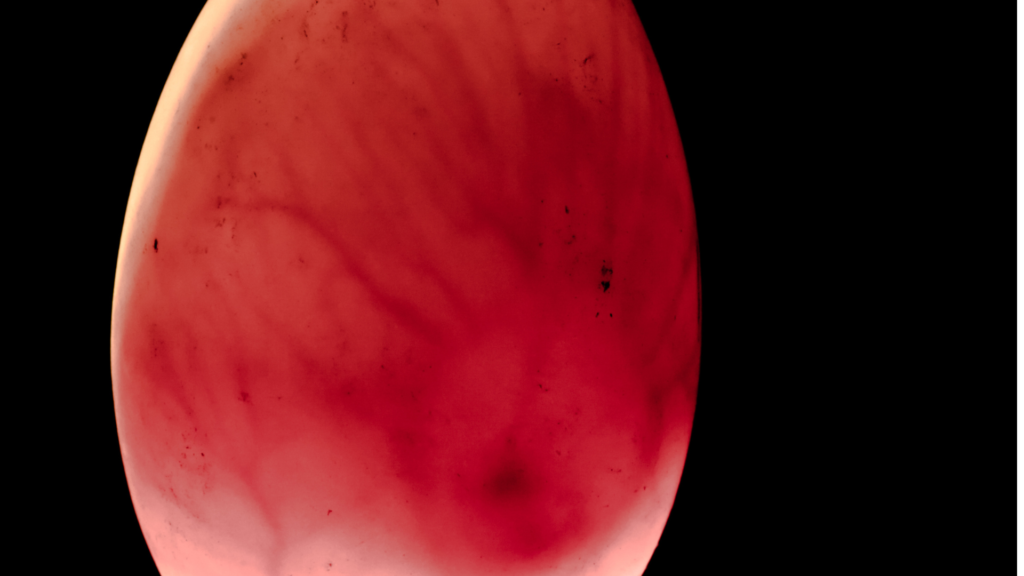
Candling is the process of shining a bright light through the egg to observe the embryo’s development. This can be done around day 7, day 14, and day 18 to monitor the progress and identify any potential issues.
Hatching and Chick Care
Rhode Island Red eggs generally have an incubation period of about 21 days. During this time, the embryos develop through various stages:
- Early development: In the first week, the embryo forms its basic structures, including the circulatory system, nervous system, and digestive system.
- Middle development: From the second week onward, the embryo starts developing feathers, beak, and claws. The chick’s organs become more defined, and it begins to take on the shape of a fully formed chick.
- Final stages: In the last few days of incubation, the chick positions itself for hatching by repositioning its body and absorbing the yolk sac. It may also start to make peeping sounds from inside the egg.
Brooding and Early care Guidelines

Once the chicks start hatching, they require proper care and attention. Follow these guidelines for brooding and early chick care:
- Maintain temperature and humidity: After hatching, transfer the chicks to a brooder box or a warm area with a temperature of around 95°F (35°C) for the first week. Gradually decrease the temperature by 5°F (2.7°C) each week until reaching the ambient temperature. Keep the brooder area dry and provide a heat source, such as a heat lamp, to maintain the appropriate temperature.
- Provide suitable bedding: Use clean and absorbent bedding material, such as wood shavings or straw, in the brooder box. This provides insulation and helps prevent moisture buildup, which can lead to bacterial growth.
- Water and feed: Provide fresh, clean water in shallow containers that are easily accessible to the chicks. Use chick-specific feed that contains the necessary nutrients for their growth and development. Ensure the feed is finely ground to facilitate consumption.
- Monitor health and behavior: Regularly observe the chicks for signs of illness, stress, or abnormalities. Look for active behavior, healthy appetite, and well-formed droppings. If any issues arise, consult a veterinarian with experience in poultry care.
- Socialization and handling: Handle the chicks gently and allow them to become accustomed to human interaction. This helps in their socialization and makes them easier to handle as they grow.
- Gradual introduction to the outdoor environment: When the chicks are several weeks old and have developed sufficient feathering, they can be gradually introduced to the outdoor environment. Ensure the outdoor area is secure and protected from predators.
By following proper breeding techniques, managing the incubation process effectively, and providing appropriate care for hatching chicks, you can contribute to the successful breeding and healthy development of your Rhode Island Reds.
Showing Rhode Island Reds
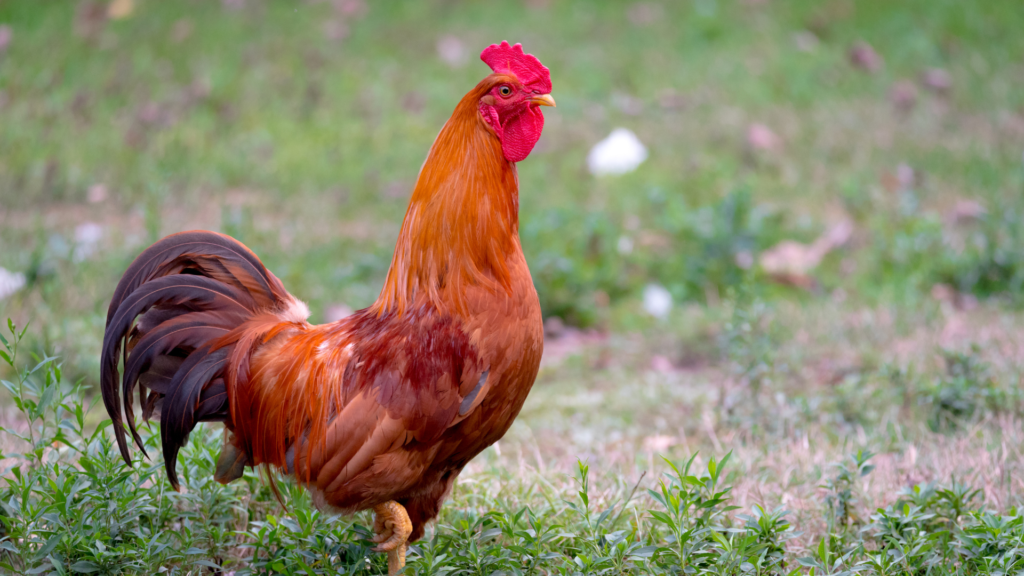
Preparation and grooming for shows
Preparing and grooming your Rhode Island Reds for shows is essential to present them in their best condition. Consider the following steps:
- Health and fitnessEnsure that your Rhode Island Reds are in optimal health and physical condition before the show. Provide a balanced diet, proper housing, and regular veterinary care to maintain their well-being.
- Feather grooming. Prior to the show, thoroughly clean the feathers of your birds. Remove any dirt, debris, or loose feathers. Trim any long or damaged feathers to achieve a neat and tidy appearance. Pay attention to the comb, wattles, and facial feathers, ensuring they are clean and free from any dirt or mucus.
- Bathing. Give your Rhode Island Reds a bath a few days before the show to make their feathers clean and glossy. Use lukewarm water and a mild poultry shampoo specifically formulated for chickens. Rinse them thoroughly and allow them to dry in a clean and warm environment.
- Nail trimming. Trim the nails of your birds to a suitable length using poultry nail clippers or scissors. Be cautious not to cut too close to the quick, as it can cause bleeding.
- Presentation. Once your Rhode Island Reds are clean and groomed, keep them in a clean and comfortable environment until the show day. Avoid exposing them to excessive dust, dirt, or extreme weather conditions that could mess up their appearance.
Criteria and standards for judging
When presenting Rhode Island Reds in shows, judges typically assess the birds based on specific criteria and standards. Some key factors that judges consider include:
- Body shape and size: Judges look for Rhode Island Reds that exhibit the standard breed characteristics, including a medium to large size with a rectangular-shaped body, well-developed breast, and a straight and broad back.
- Feather color and pattern: Rhode Island Reds should have a deep, rich mahogany red color throughout their feathers. The color should be consistent and uniform, without any white or off-colored feathers. The feathers should be glossy, lustrous, and tightly held to the body.
- Comb and wattles: Rhode Island Reds have a single comb that should be upright, well-developed, and free from deformities or damage. The wattles should be medium-sized and evenly matched.
- Leg and foot color: The legs and feet of Rhode Island Reds should be a bright yellow color. Any other coloration or pigmentations on the legs may be considered a fault.
Tips for presenting Rhode Island Reds in shows
To increase your chances of success when presenting Rhode Island Reds in shows, consider the following tips:
- Know the breed standard: Familiarize yourself with the breed standard and criteria for judging Rhode Island Reds. Understand the ideal characteristics and qualities that judges will be looking for.
- Practice handling and posing: Train your birds to be comfortable with handling and posing. Practice presenting them in a way that showcases their best features, such as holding them securely but gently and positioning them to highlight their body shape, comb, and feather color.
- Pay attention to details: Ensure that your birds are clean, well-groomed, and in excellent condition. Check for any loose feathers, dirt, or other imperfections and make necessary adjustments before entering the show.
- Maintain a calm and confident demeanor: Present your birds in a calm and confident manner. Avoid any sudden movements or stressful situations that could agitate or disturb your Rhode Island Reds.
- Seek feedback and learn from experienced exhibitors: Participate in local poultry shows and seek feedback from experienced exhibitors or judges. They can provide valuable insights and tips for improving your presentation skills.
By properly preparing your Rhode Island Reds, understanding the judging criteria, and following these tips, you can enhance your chances of success when showing your birds. Remember
Frequently Asked Questions about Rhode Island Reds
Here are some frequently asked questions about Rhode Island Reds:
Are Rhode Island Reds good for beginners?
Yes, Rhode Island Reds are often recommended for beginners in poultry keeping. They are hardy, adaptable, and easy to care for. Their dual-purpose capabilities make them a practical choice for both egg production and meat.
How many eggs can I expect from a Rhode Island Red per week?
On average, a healthy Rhode Island Red hen can lay approximately 4 to 6 brown eggs per week. However, individual egg production may vary based on factors such as age, diet, health, and environmental conditions.
Are Rhode Island Reds suitable for free-ranging?
Yes, Rhode Island Reds can adapt well to free-ranging environments. They have a good foraging instinct and are generally active and alert. However, it’s important to provide them with a secure and predator-proof area if you choose to free-range them.
Do Rhode Island Reds do well in hot climates?
Rhode Island Reds have moderate heat tolerance and can handle warm climates reasonably well. However, they may require extra shade, access to cool water, and proper ventilation during hot summer months to prevent heat stress.
Can Rhode Island Reds be kept with other chicken breeds?
Yes, Rhode Island Reds generally get along well with other chicken breeds. They have a calm temperament and can adapt to various flock dynamics. However, it’s important to monitor their interactions and ensure adequate space and resources for all chickens.
How long do Rhode Island Reds live?
Rhode Island Reds have an average lifespan of 5 to 8 years, depending on their overall health and care. With proper nutrition, housing, and healthcare, they can live a long and productive life.
Are Rhode Island Reds prone to any specific health issues?
Rhode Island Reds are generally resilient. However, they can be susceptible to common chicken health issues such as respiratory infections, parasites, and reproductive disorders.
Regular health checks, proper hygiene, and vaccination when necessary can help prevent and manage these issues.
Can I keep a rooster with my Rhode Island Red hens?
Yes, keeping a rooster with Rhode Island Red hens is common and can encourage natural mating and potentially lead to fertile eggs for hatching. However, be aware that roosters can be territorial and may exhibit aggressive behavior towards humans or other chickens. It’s essential to handle and manage the rooster appropriately to maintain a harmonious flock.
Remember that individual experiences with Rhode Island Reds may vary, and it’s always important to consult reliable sources or seek advice from experienced poultry keepers for specific questions or concerns related to your chickens.
